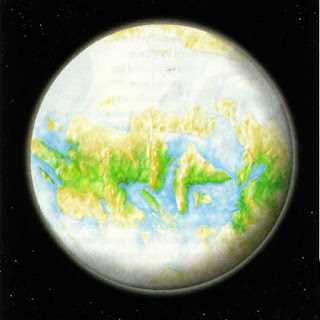Rescuing the Snowball Earth Scenario
In their efforts to deny the literal history recorded in Genesis, secular scientists have caused themselves a great deal of scientific and intellectual trouble. Some jasper will dream up a scenario that seems plausible at first glance, then the facts contradict it. For example, the Ice Age.
In fact, they wanted more ice ages. However, there was this small problem of evidence — t'weren't none. At least, not for the number they wanted spread out over five major periods. The Snowball Earth concept has most of the planet covered in ice, but has problems they just can't skate around.
Louis Agassiz was not the first to propose an ice age, but he was persistent. It was doubted at first, but when secular geologists realized that it would help them distance themselves from geology caused by the Genesis Flood, they saddled up.
 |
| Snowball Earth image: Flickr / guano (CC BY-SA 2.0) |
One of these is the "Faint Young Sun Paradox", where the sun is too cool to provide enough warmth to support minerals-to-mycologist evolution, so the ice sheets should remain. In addition, ice sheets would reflect light back out into space, keeping the planet cold. Then there's the problem that secularists cannot account for how an ice age would begin. Creation science models based on the Genesis Flood once again provide the most logical scenarios for the Ice Age.
One rescuing device is that the huge ice age was ended with a little help from a meteorite. Of course, it seemed reasonable to some, but others pointed out that there are problems with that idea as well. Their rescuing devices are like lead-lined lifejackets — they only make things worse.
Ever since the discovery that Earth had once been glaciated to a far greater extent than it is today, the Ice Age has been an iconic feature of secular geology. Although a single ice age in the recent past challenged the notion of uniformity of Earth’s gradual processes, the uniformitarian multiplication of Earth’s glacial periods was quickly heralded as a victory for the antiquity of Earth, despite the evidence supporting a single glaciation. . . .These Huronian glaciations, among others, are opined to have been uncommonly extensive, dominating the majority of Earth’s surface, even to the equatorial regions. Popularly termed ‘snowball Earth’, this inference has nearly gained consensus in secular geology and great repute in the entertainment sector. . . . In a desperate attempt to save the paradigm, a recent study has suggested that an asteroid impact...
Although a bit on the technical side, the entire article should be of interest to a range of people. To read it all, ski on over to "‘Snowball Earth’ out with a bang?"